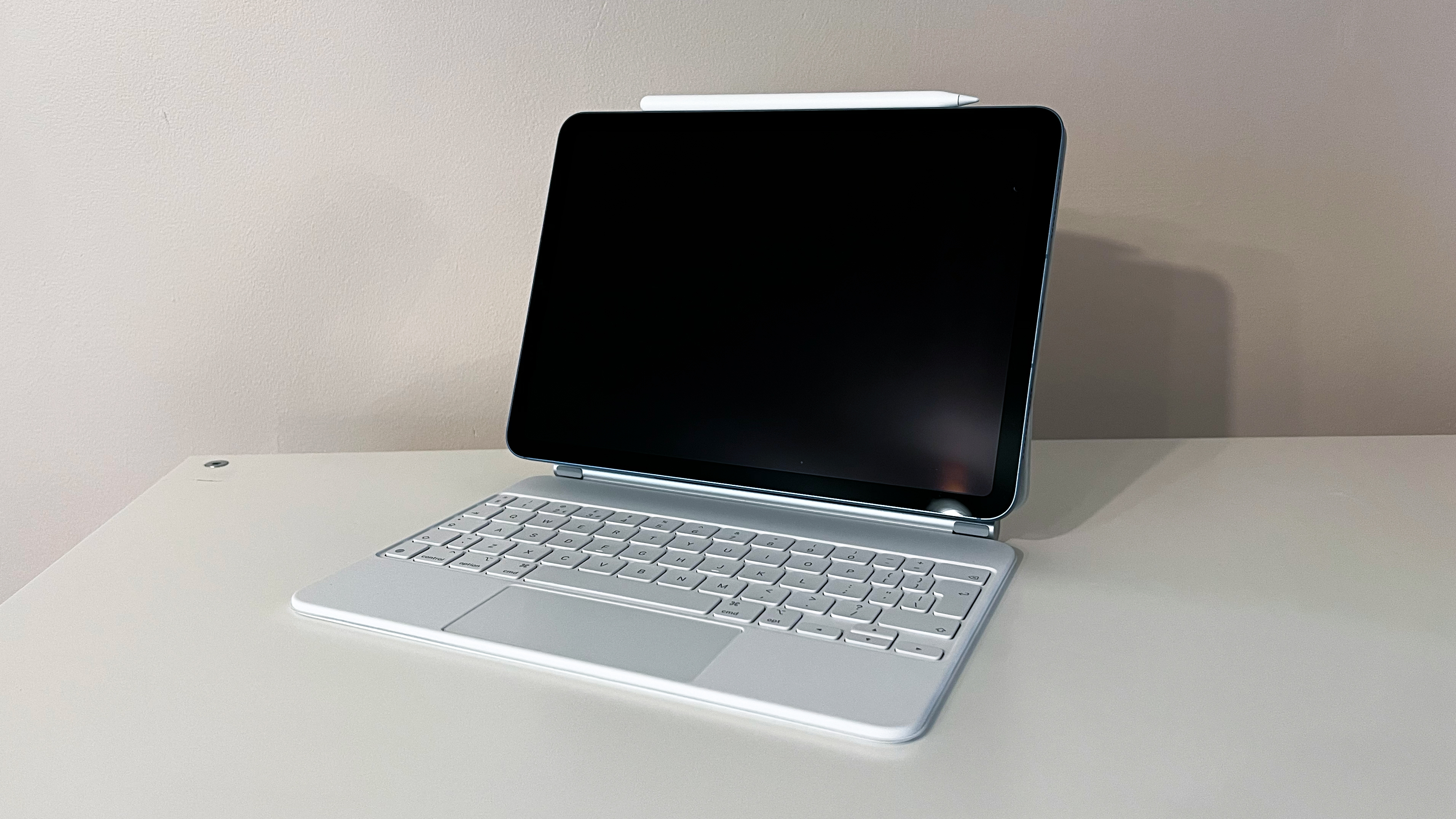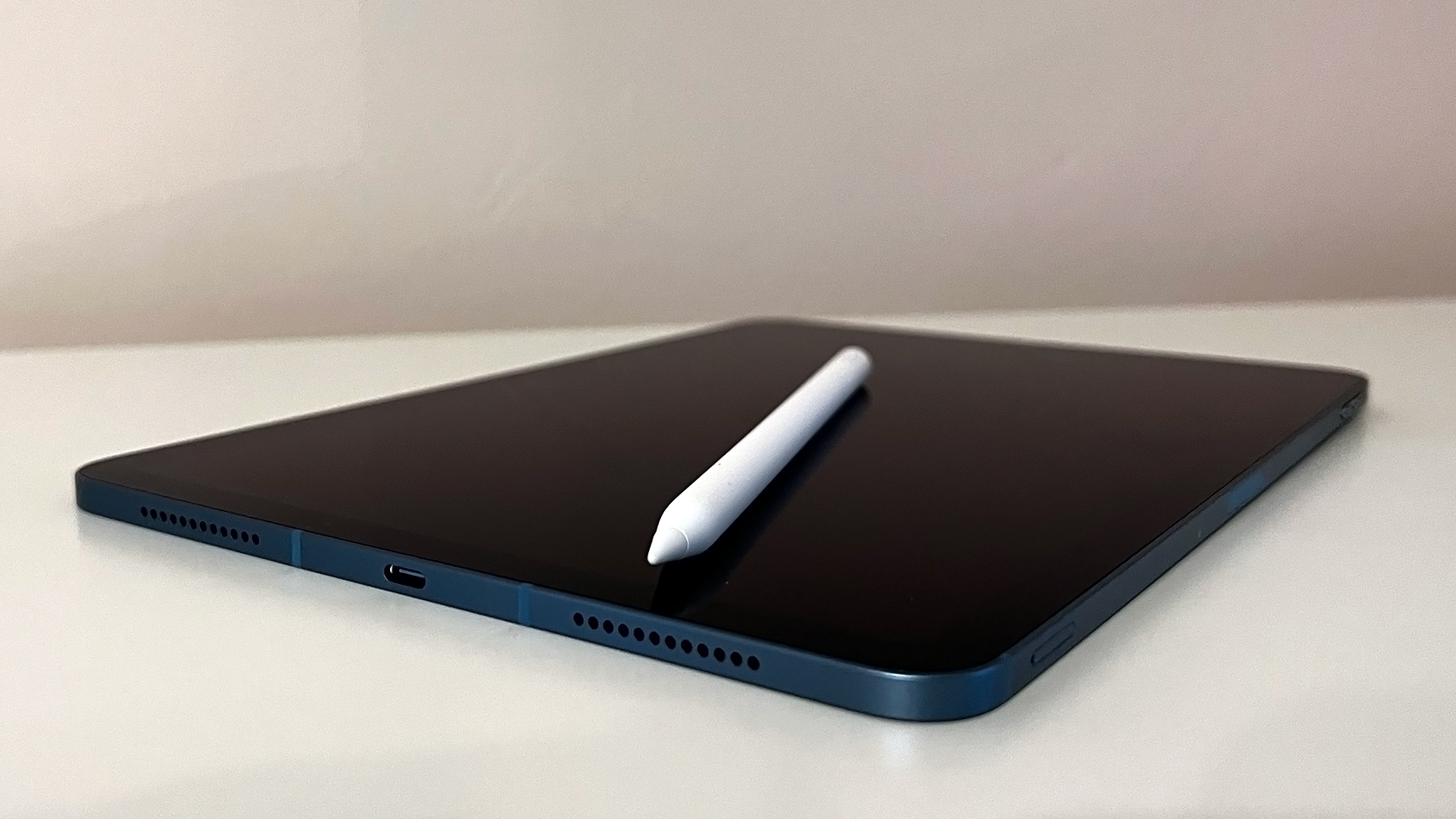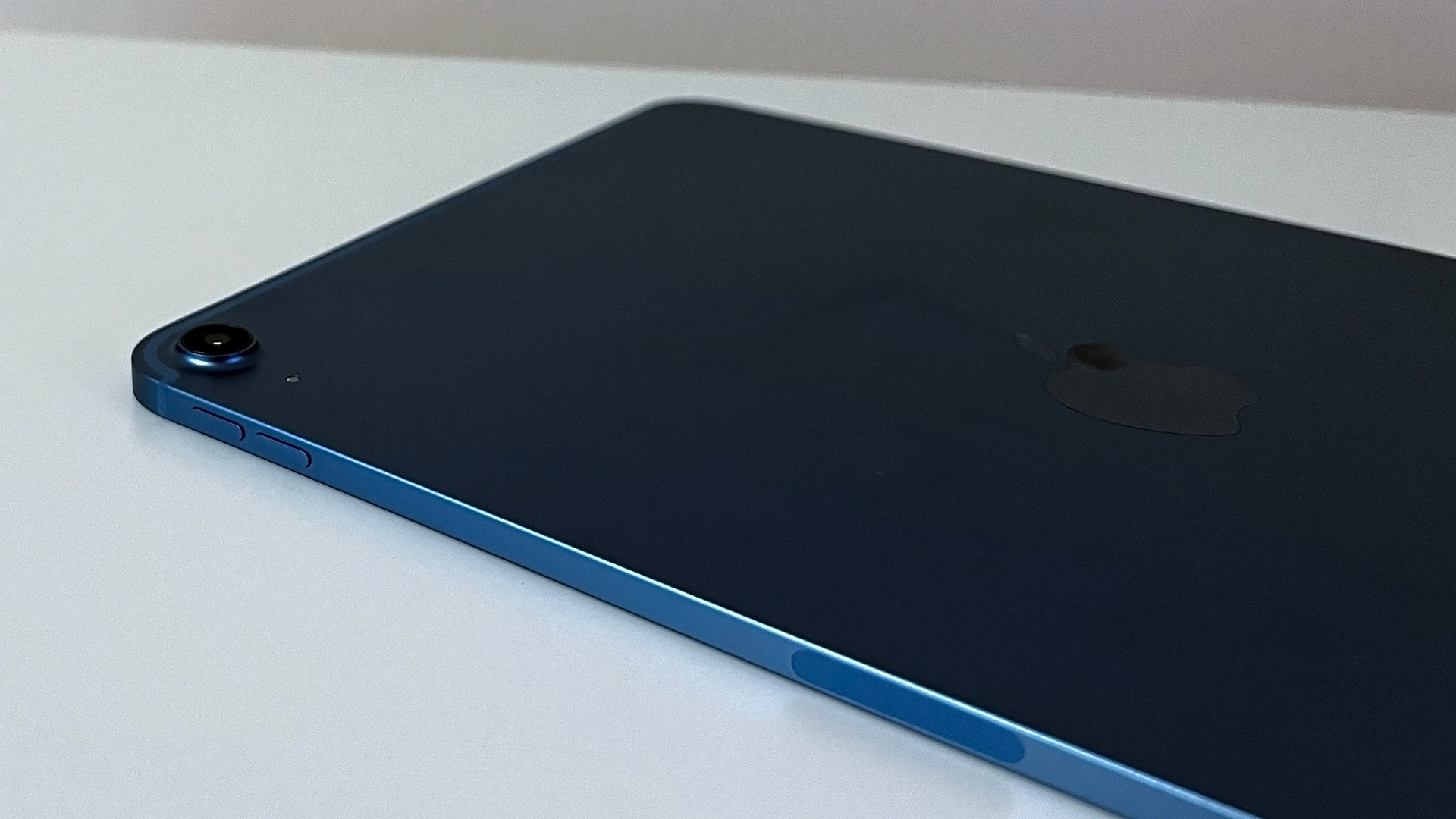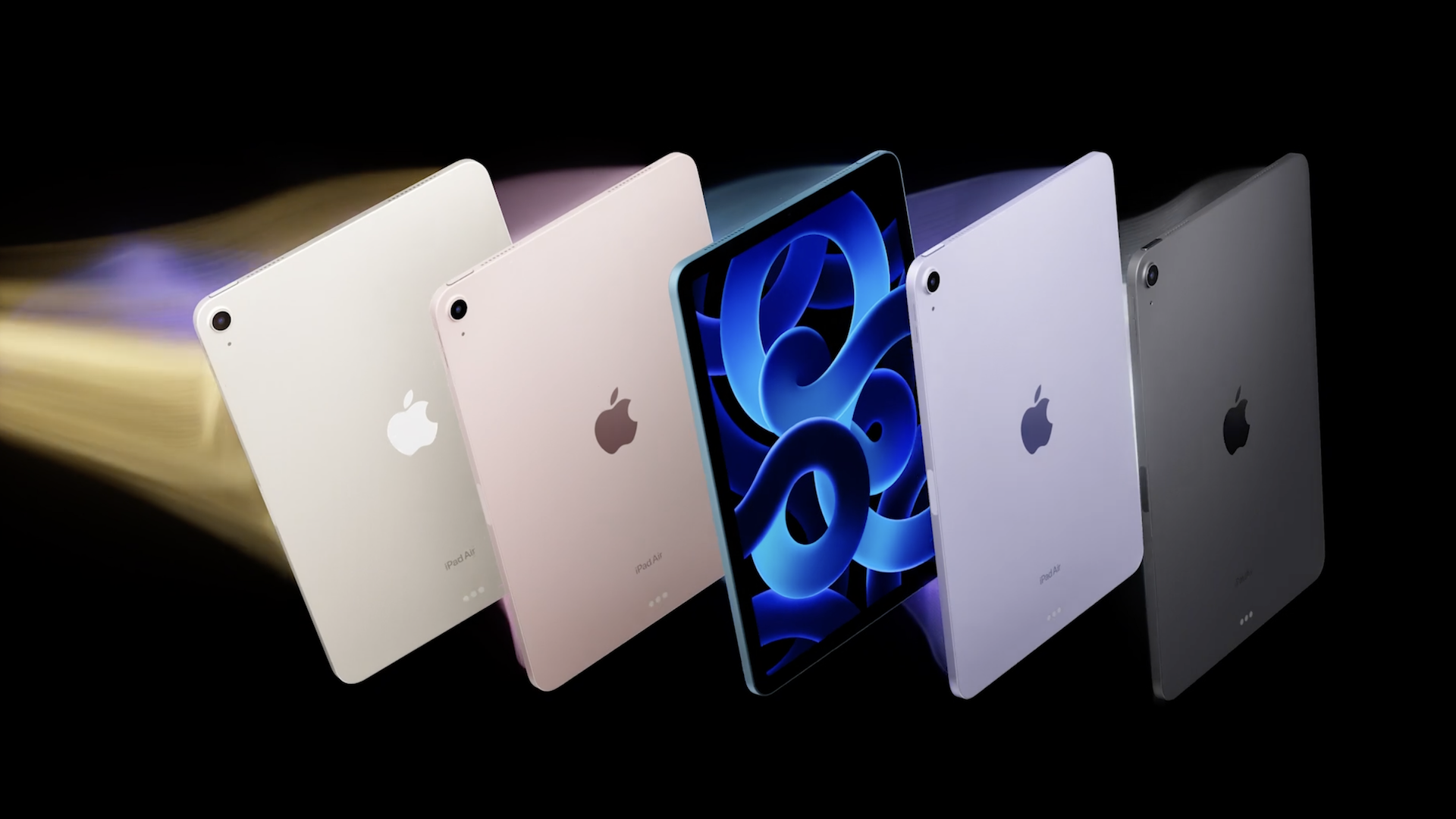Our Verdict
The iPad Air (5th Gen) is an incredible computer for the price, delivering a notepad-sized package with the power of a MacBook Pro. The Apple M1 chip is able to handle almost anything you can throw at it from iPadOS' great range of creative apps, the screen is sharp and accurate, and it's light enough to go anywhere with you. There are still good reasons to go with the iPad Pro instead (especially the bigger 12.9-inch model), but they're increasingly pushed to the fringe – this iPad Air is a fully formed creative powerhouse even without the 'pro' name.
For
- Ridiculously powerful
- Great screen for accuracy
- Sleek, portable design
Against
- Screen is 60Hz, no HDR
- No 3.5mm jack
Why you can trust Creative Bloq
Size: 247.6x178.5x6.1mm
Weight: 461g (Wi-Fi only); 462g (Wi-Fi+cellular)
Processor: Apple M1, 8GB RAM
Resolution: 2350x1640
Screen: 10.9-inch IPS LCD
Storage: 64GB/256GB
Battery: 28.6 watt-hour
The iPad Air (5th Gen) takes a design that already followed in the footsteps of the iPad Pro, then throws in the latest iPad Pro range's party piece – the powerful Apple M1 processor – to create a mid-range tablet that's even more tempting.
There isn't a long list of other changes from the previous version of the iPad Air – a better front camera, improved USB-C and the option of 5G connectivity – but this tablet just had an overhaul, and wasn't in need of another.
All it needed was a bit of modernification, because the cheaper iPad mini (6th Gen) and iPad 10.2 (9th Gen) had both come out since then, with some features that left the Air behind. But Apple didn't stop at modernising it – it massively juiced it up at the same time.
When the iPad Pro (2021) came out, its use of the Apple M1 chip was a revolution. It put the tablet in the same league as the MacBook Pro 13-inch (M1, 2020) for computing power – in the same league as the older Intel 16-inch MacBook Pro, even.
That makes total sense for a 'pro' machine – but now that the M1 is in the iPad Air as well, the cat is really among the shiny black pigeons for creatives wondering which of the current iPad generations is best for them.
So is the iPad Air the new go-to for pros wanting to maximise their budgets? Do the features that are pared-back from the iPad Pro leave it feeling wanting? Here's our verdict.
iPad Air (5th Gen) review: price
The iPad Air (5th Gen) is released on March 18th 2022.
The most basic version of it will cost you £569/$599/AU$929, which includes 64GB of storage – that's fine for home use, but is likely to end up a bit restrictive for creative work.
The better option is likely to be the 256GB version, which costs £719/$749/AU$1,159 – this should be fine unless you're looking for it to be a true laptop replacement.
This is, however, the largest that you can get in the iPad Air. If you want bigger, the iPad Pro can go up to 2TB. We should also note here that you can get the iPad Pro 11-inch 128GB for £749/$799/AU$/1,199 – and that's a very tough decision. For only a little more money, you'd get a brighter 120Hz ProMotion screen, a Thunderbolt 4 port, better dual-lens camera with LiDAR, and a front camera with Face ID and True Depth sensor… but less storage, and you wouldn't get to choose funky colours.
The prices above are for the Wi-Fi-only version – to add 5G connectivity, it'll be an additional £150/$150/A$230 on top of the existing price. See our regularly updated roundup of the best iPad Air 5 prices to find the best deals where you are.

iPad Air (5th Gen) review: display
The screen on the new iPad Air basically hasn't changed from the previous version, which means you get a 2360x1640 IPS LCD panel. That's 264 pixels per inch, which isn't as sharp the iPad mini (6th Gen) or phone screens, but is perfectly suitable detailed for the distances you'll usually use the iPad Air.
Resolution is one area where you don't get any advantage from switching up to the iPad Pro from the Air – that's also 264ppi.
With great DCI-P3 colour support and superb accuracy, it's a great screen for creative use overall. The backlighting lighting is even, and contrast is good – the maximum typical brightness of 500 nits gives media and apps a fair amount of vibrancy.
Having said that, the 600 nits of brightness you get from the 11-inch iPad Pro is a clear improvement side by side – though individually, it's harder to spot a marked change. That's a bit different for the 12.9-inch iPad Pro, with its mini-LED 'XDR' display that can reach 1,000 nits of full0screen brightness for HDR content – that's clearly something special when you use it even without other screens nearby.
The lack of 120Hz screen is only a practical concern for Apple Pencil 2 users, because doubling the refresh rate halves the time it takes to see the results of your drawing on-screen, and faster response times make it easier to be accurate when precision drawing.
For more casual drawing, 60Hz is fine (the Apple Pencil samples at a higher rate still, for smoother lines). For note-taking, 60Hz is fine. For photo editing using the Pencil 60Hz is fine.
Otherwise, 120Hz just looks nice for animations and scrolling. When you've tried it, going back to 60Hz feels jerky and blurred – but there's no real practical benefit. It's just smoother.
iPad Air (5th Gen) review: Apple Pencil 2
As mentioned above, Apple Pencil 2 is supported here fully. This means the Pencil magnetically attaches to the side of the iPad not only for storage, but also to wirelessly charge when there, so it's always juiced and ready to go when needed.
Attaching it to the side also pairs it with that iPad instantly, so there's not hassle at all setting it up, or even switching between iPads.
We love the matt finish of the Apple Pencil 2 (compared to the glossier first version), and its accuracy for tilt and pressure is excellent. The hard tip on the glass takes a little getting used to, but it's hard to fault.
As mentioned above, the Pencil experience is better on iPad Pro because of the 120Hz screen refresh speed, but ultimately it's still great here.

iPad Air (5th Gen) review: power and performance
Well. The Apple M1 chip used here is a behemoth for a fan-less tablet. You get eight processor cores (four high-performance cores, and four energy-efficient cores, though all can be used at once), 8GB of RAM, and eight GPU cores.
The only difference from the iPad Pro's chip is that you could get a version with 16GB of RAM on the iPad Pro (if you buy 1TB or 2TB of storage). Otherwise, this is the same silicon that's so impressed everyone – in the various benchmarking tests we tried, it and the 12.9-inch iPad Pro with M1 were effectively identical.
We recorded Geekbench 5 scores of 1713 for single-core performance, 7274 for multi-core performance, and 21212 for GPU compute performance. For comparison, the high-end late-2019 Intel MacBook Pro 16-inch (with eight-core Intel Core i9 processor and AMD Radeon 5500M GPU) scores around 1100, 7000 and 30000 in those tests, respectively.
So we're talking more processor performance than a high-end MacBook Pro – in a mid-range tablet.
The thing is, though, that you won't notice this performance most of the time. Apple phone-level chips – as used in the previous iPad Air, as well as in the iPad mini (6th Gen) – are already incredibly snappy. The iPad Air isn't really any faster than its predecessor when it comes to generally moving about iPadOS – but let's be clear that it is always fast.
Flicking through a huge photo library, choosing a big DSLR photo, zooming all the way in, and then backing all the way back to thumbnails in the library reveals absolutely no stutter, no pauses.
This translates through into apps. Illustrations with over a hundred layers are instant to react in Serif Affinity Photo, with effects applied just as quickly. Video editing in LumaFusion is the same – playback is instant on multiple tracks of 4K footage, and applying any kind of filter or grading adjustment happens with no delay at all, after which you can immediately resume playback with it applied, no matter how long the clip or how many adjustments.
We didn't try anything that the M1 struggled to achieve, though it certainly could be possible – image creation with giant canvas dimensions and many layers will certainly hit RAM limits if you go wild.
It's great to have 5G here as an option, now that you can make more complex creations than ever. As usually, performance will vary widely depending on network and coverage, but in our experience, breaking 300Mbps download and 30Mbps upload is no sweat in a well-supported area.
Apple's usual claims of 10 hours of battery life for casual use – web browsing and so on – are here, and we saw great battery life in our usage of it. It also hold its charge really well between uses – again, just as its predecessors have.
However, when watching a movie streaming from the Apple TV app, we saw the battery drain at more like 20% per hour – so if you're streaming movies, expect a significant reduction in that figure.
If you let the M1 chip off the chain, you can also drain it very quickly. Running Geekbench 5's CPU benchmarks, for example, gave us a 5% drop in battery in just a few minutes. In reality, few tasks will push the processor so hard without any pausing, so don't think that drawing in ProCreate is going to give you the same issues, but it's a reminder that this is a small device with a very potent chip in, which means the chip can eat the battery if it really wants to.

iPad Air (5th Gen): key features
The two notable upgrades on this iPad that we haven't mentioned yet are the front camera and the USB-C port.
The latter is simple, so let's get it out of the way: it's been upgraded to a USB 3.1 Gen 2 port, which means max speeds of 10Gbps – it was 5Gbps before. The iPad Pro's Thunderbolt 4 port can hit 40Gbps.
The front camera is now a 12MP sensor with ultra-wide lens, and it supports Apple's Centre Stage feature. This means that in compatible apps, the camera detects your face, and crops and frames you in shot. If you move after that, it can actually follow you in its 122-degree field of vision, because it has a lot of unused view.
If it detects more than one person, it'll do a wider crop to fit you both in – and it'll change on the fly as people come in and out of view.
It's a very smart and useful feature – you can be on a call and need to move around slightly to grab something or shove the cat away or whatever, and it just smoothly follows you.
There's 4K video recording at 60fps, but not with Dolby Vision HDR, unlike iPhones. The quality of the cameras is fine – they're softer and noisier in middling light than the latest iPhones, but they pull in a fair amount of light and still capture detail.
In brighter daylight, they're pretty sharp and vibrant. Basically, no replacement for a good phone camera, but they do the job.
The stereo speaker are good – they can create some impressive spatial separation when the tablet is held in front of you. They're tuned well for clarity, with speech punching through with definition even from low volumes. They produce enough bass to add depth to music or movies, though obviously nothing like a set of good headphones or speakers would – but they make sure that you get a balanced sound.
On the back of the iPad Air is the Smart Connector, which means you can connect it to compatible accessories: this is mostly keyboards right now, including Apple's Magic Keyboard.
Touch ID is used for biometric security, and this is built into the Lock button. It works well.
iPad Air (5th Gen): design
The iPad Air sticks with the same design, which means it looks very much like the iPad Pro and the iPad mini. It's all flat sides with meticulously machined curves joining them at right angles, so there's no pointy part digging into your palm.
As ever, Apple's aluminium finish feel very premium, and there's a small range of colours. We had the blue for testing, and it's by far our favourite.
The only small issue is that the uniform design when viewed from the front can make it a small pain to work out where the Touch ID button is when you pick up.
iPad Air (5th Gen) review: should you buy it
The iPad Air is a pretty astounding creative computer for under £600/$600. A high-quality screen, supreme portability, a huge range of interesting apps from music synths to advanced image editing, and enough power to make sure that you can do whatever you want with them.
The iPad Pro 11-inch still offers more, no question – the brighter screen busts reflections better, the 120Hz refresh rate improves the Apple Pencil experience, and the Thunderbolt 4 port gives extra flexibility. But these are now niche improvements that not everyone needs – for most people, the iPad Air is already as much tablet as you can possibly make use. Maybe even more.

Thank you for reading 5 articles this month* Join now for unlimited access
Enjoy your first month for just £1 / $1 / €1
*Read 5 free articles per month without a subscription

Join now for unlimited access
Try first month for just £1 / $1 / €1
out of 10
The iPad Air (5th Gen) is an incredible computer for the price, delivering a notepad-sized package with the power of a MacBook Pro. The Apple M1 chip is able to handle almost anything you can throw at it from iPadOS' great range of creative apps, the screen is sharp and accurate, and it's light enough to go anywhere with you. There are still good reasons to go with the iPad Pro instead (especially the bigger 12.9-inch model), but they're increasingly pushed to the fringe – this iPad Air is a fully formed creative powerhouse even without the 'pro' name.
Matt is Managing Editor at TechRadar.com, and previously worked on T3, MacLife and MacFormat. He's been testing technology for over a decade, working in specialist Apple publications as well general technology and creative journalism, and has charted Apple’s ups and downs since his student days (but still hopes to hear “one more thing”). By day, you can find him covering TV, audio, smart home gear and more at T3.com, as Home Tech Editor. By night, he's probably updating or pairing or installing some new piece of technology in the quest for the perfect setup.


